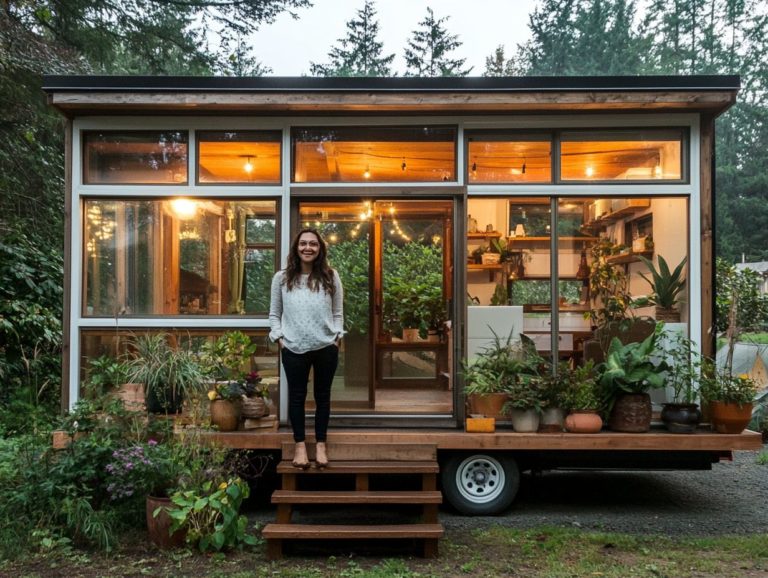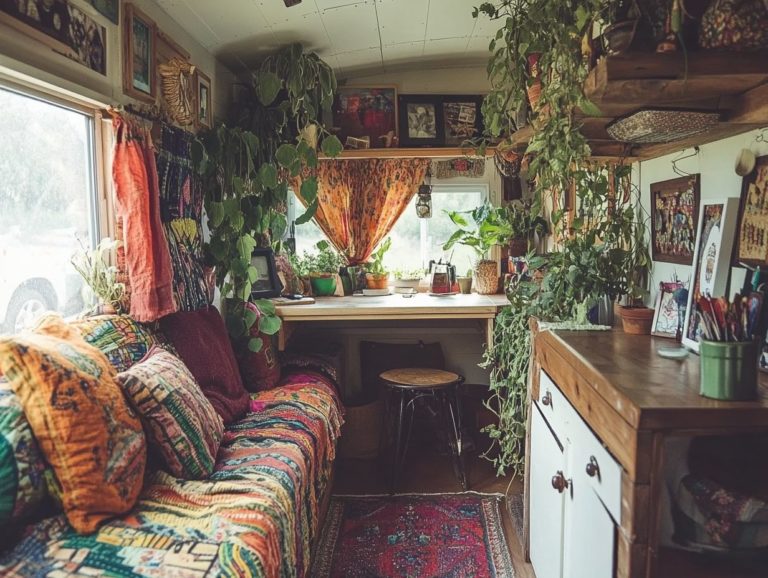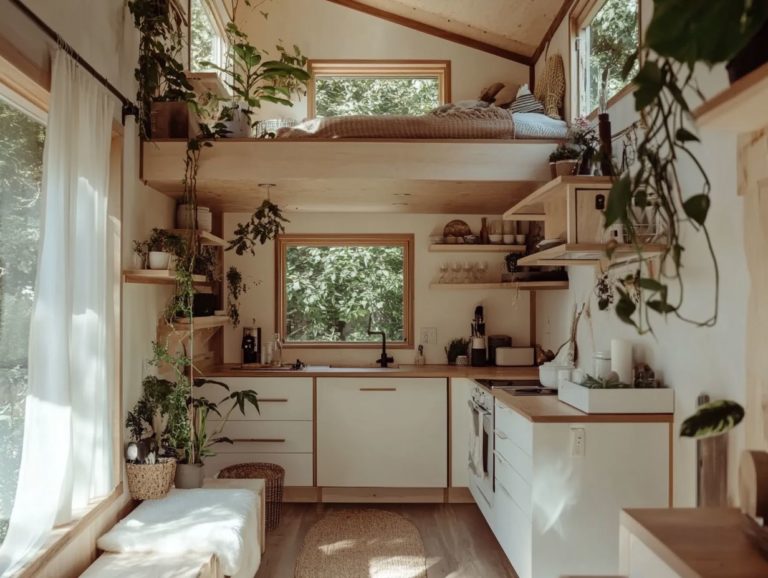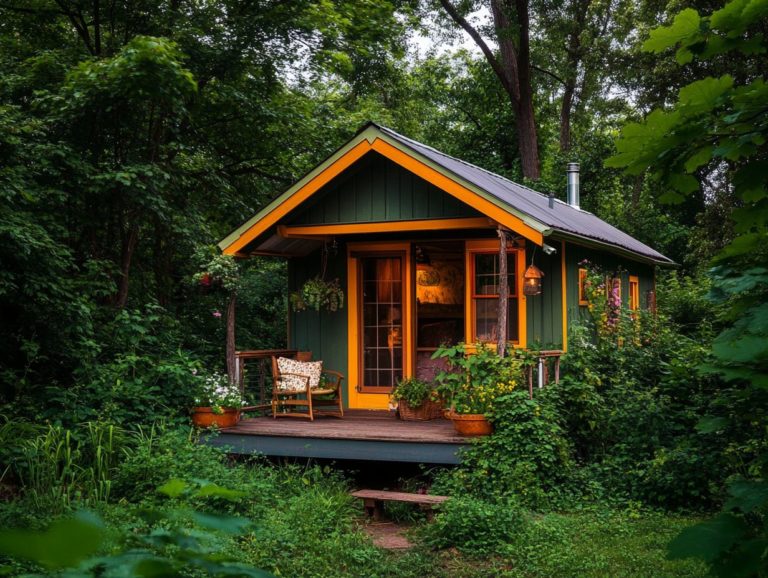5 Tips for Decorating Your Tiny Home
Decorating a tiny house brings its own delightful challenges and opportunities. With limited floor space at your disposal, balancing creativity and practicality is essential.
Here are five indispensable decorating tips for maximizing your space think vertical dimensions and multi-functional pieces that do double duty.
- Discover how to craft an inviting atmosphere with light colors and clever use of mirrors.
- Uncover the advantages of tiny living.
- Avoid common decorating missteps, especially in small spaces.
- Explore budget-friendly ideas to express your personal style in every corner, utilizing creative storage solutions.
Get ready to turn your tiny space into a stunning masterpiece by incorporating natural materials and thoughtful color palettes!
Contents [hide]
Key Takeaways:
- Utilize vertical space to maximize storage and create the illusion of more space.
- Choose space-saving furniture to save on space and money.
- Incorporate light colors and natural light to make the space feel bigger and brighter.
1. Utilize Vertical Space
In the world of tiny living, maximizing vertical space is a helpful approach that turns limited areas into functional and appealing environments. It embodies the essence of minimalism while ensuring tidy storage solutions.
By choosing floating shelves that you can easily rearrange or swap out with the changing seasons, you can showcase your personality while optimizing storage. Adding hanging plants introduces a refreshing touch of nature, enhancing air quality and breathing life into your walls without encroaching on precious floor space.
To complement an open floor plan, opt for lighter colors and natural materials think wood or metal to create an airy ambiance that makes your space feel larger and more inviting. Thoughtfully placed small decorative accents on vertical surfaces can further enrich your design, transforming practicality into an artistic statement that truly reflects your unique style.
2. Choose Multi-Functional Furniture
In a tiny house, choosing multi-functional furniture is key to maximizing every inch of your available space while maintaining a cohesive and stylish decor that reflects a minimalist lifestyle.
This choice is important for versatility. For example, pieces like sofa beds, lift-top coffee tables, and storage ottomans do more than just serve their primary functions; they offer extra sleeping areas and hidden compartments. These elements keep clutter at bay, allowing for a clean and open ambiance.
In the kitchen, opting for compact appliances lets you enjoy modern conveniences without sacrificing valuable counter space. By harmonizing these pieces with your overall color palette think neutral tones or complementary textures you can create a visually appealing environment that feels both spacious and inviting.
3. Use Light Colors and Natural Light
In tiny houses, using light colors and abundant natural light is crucial for crafting a bright, airy atmosphere. This approach makes small spaces feel larger and enhances your overall home decor.
By choosing whites and soft pastels, you visually expand your living areas, reflecting light and creating an illusion of openness. Expertly placed windows are key; when positioned to capture sunlight at different times of the day, you ll notice a significant boost in brightness throughout your space.
Integrating mirrors amplifies that natural light and adds depth to your design. To keep your interior lively, consider adding strategic pops of vibrant color. These touches can create striking focal points, ensuring your tiny home remains cohesive and stylish without overwhelming your senses.
4. Get Creative with Storage Solutions
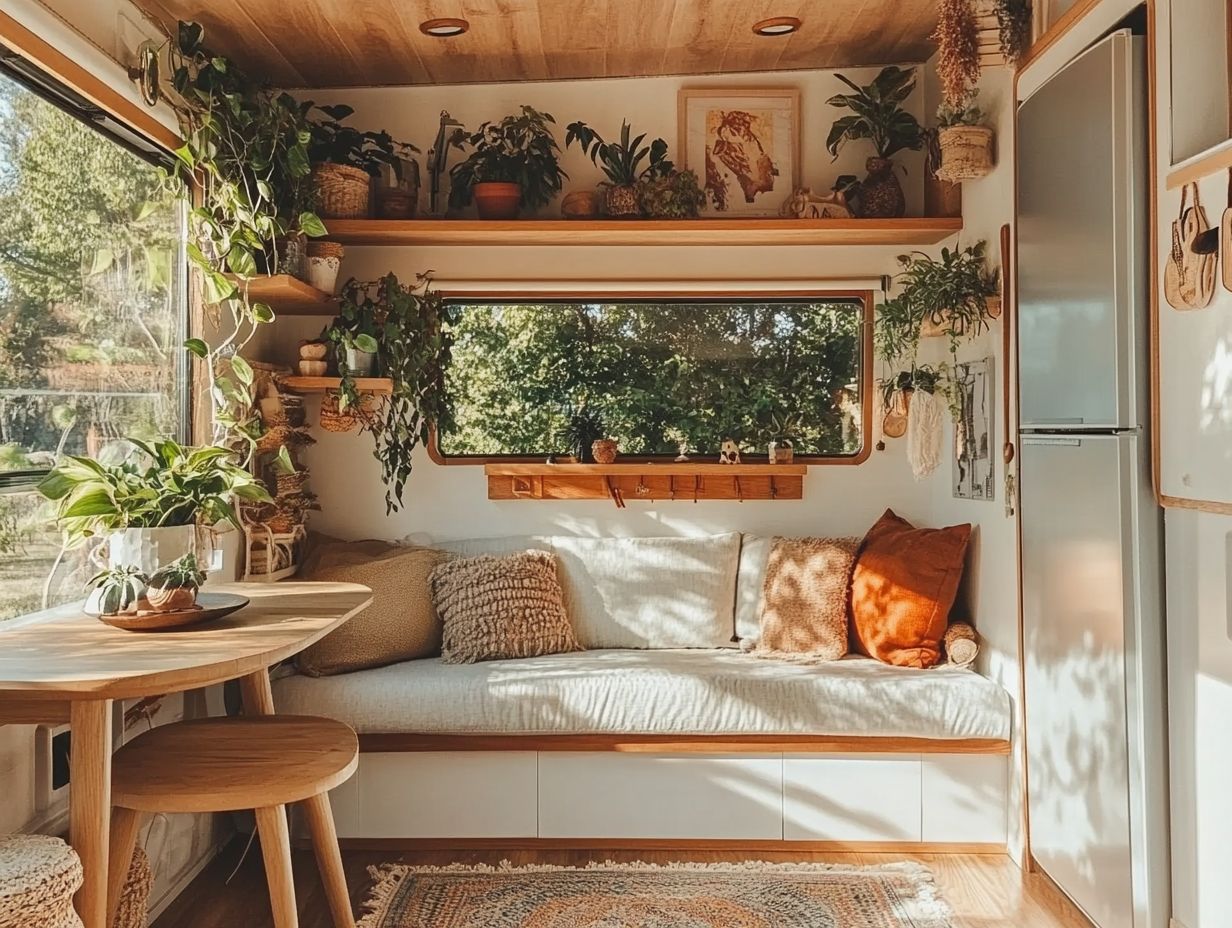
Creative storage solutions are essential in tiny houses. They help you maintain organization, declutter your spaces, and make the most of every square inch. This ultimately enhances the overall functionality of your small abode.
By embracing innovative ideas like under-bed drawers, built-in cabinetry, and concealed compartments, you can maximize your limited square footage. These elements elevate the aesthetic appeal of your home while providing easy access to your belongings.
When pursuing simplicity, adopt practical decluttering techniques. Assess items based on their utility and emotional value. An organized home supports your minimalist lifestyle, emphasizing functional design over excess. This cultivates a serene environment where every item has its purpose.
5. Incorporate Mirrors to Create the Illusion of Space
In designing tiny houses, incorporating mirrors is an effective way to create the illusion of space. They reflect natural light, enhancing the perception of height and contributing to a more open and airy environment.
Strategically placing mirrors can further optimize these benefits. Make every corner of your small home feel less confined and much more welcoming. For instance, position a large, decorative mirror across from windows to maximize sunlight and create a lovely play of light throughout the room.
You can explore various styles, from rustic frames to sleek, modern designs. This ensures mirrors serve both functional and aesthetic purposes.
To maintain a cohesive look, use frames in the same material or color as your other furnishings. This will ensure that reflective elements blend seamlessly into your overall interior scheme, enhanced by tasteful wall decor.
What Are the Benefits of Living in a Tiny Home?
Living in a tiny house offers numerous benefits, including improved home organization and a significant reduction in clutter through intentional design. It promotes a minimalist lifestyle that encourages mindfulness and the efficient use of space-saving furniture.
By embracing this living arrangement, you unlock considerable financial savings, particularly through lower utility bills and reduced maintenance costs. Minimizing your living space and consumption patterns likely leads to a substantial decrease in your environmental footprint, nurturing a sustainable lifestyle that champions eco-friendliness.
This transition also grants you increased mobility, allowing the freedom to relocate with ease for leisure or professional opportunities. Ultimately, by adopting this simpler way of living, you may discover a newfound sense of satisfaction and well-being. Focus on what truly matters: experiences, relationships, and personal growth.
What Are the Main Challenges of Decorating a Tiny Home?
Decorating a tiny house presents unique challenges, particularly when maximizing limited floor space. You need to craft a functional and aesthetically pleasing environment that showcases your personal style and comfort through smart home decor.
You’ll often select appropriately sized furniture that complements rather than overwhelms your space. Coordinate color schemes that create a sense of openness, and ensure everything remains organized and easy to access. Balancing style with utility can be tricky, prompting you to seek out innovative solutions and clever storage options.
To successfully navigate these hurdles, embrace multi-functional furniture that adapts to your needs. Utilize lighter colors to enhance visual space, and incorporate smart organizational tools that keep everything in its designated place while maintaining an inviting ambiance, especially in small spaces.
Start transforming your tiny home today with these creative solutions!
How Can One Make the Most of Limited Space in a Tiny Home?
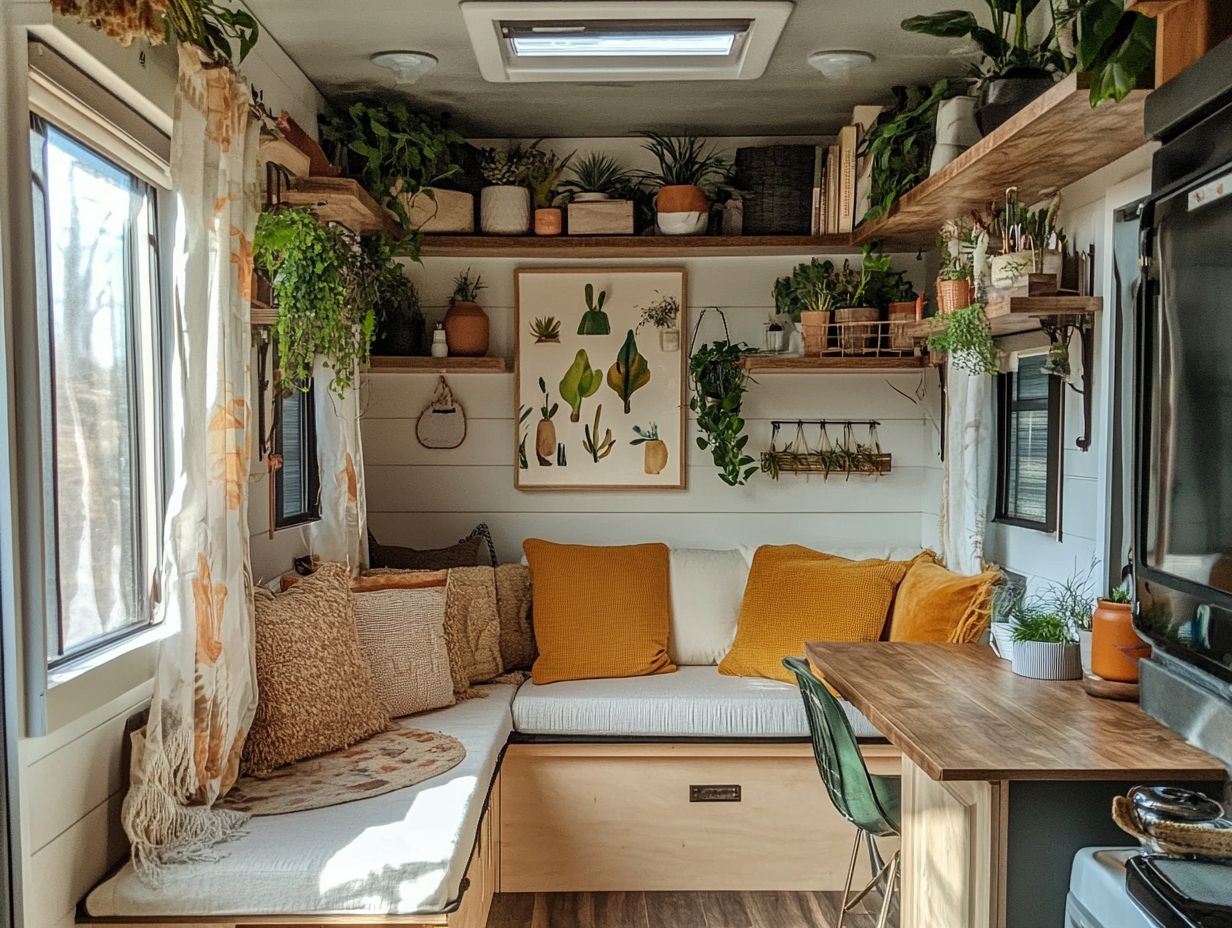
To maximize space in a tiny house, embrace innovative organization techniques. Choose space-saving furniture that embodies functional minimalism.
Thoughtfully plan your layout. Incorporate vertical storage solutions to effectively utilize every inch of available space. Wall-mounted shelves, hooks, and cabinets help keep items off the floor, creating an open and airy feel.
Select multi-functional furniture like a bed that serves as a storage unit or a coffee table that transforms into a dining table to enhance practicality while minimizing clutter.
Establish an effective organization system with categorized bins and color-coded labels. This will help maintain order and accessibility, ensuring that even the coziest areas feel spacious and inviting, especially when paired with rugs that define spaces.
What Are Some Common Mistakes to Avoid When Decorating a Tiny Home?
Avoiding common mistakes is crucial for crafting a harmonious living space in a tiny house. Misjudging scale, overcrowding areas, and neglecting effective organization can disrupt the flow of your home.
Pay close attention to your choice of furniture. Oversized pieces can quickly overwhelm a small area, turning it into a cramped space instead of the inviting haven you envision.
Choose multi-functional furniture to elevate your space utilization. Smart storage solutions can meet your daily needs while enhancing your environment.
Adopt a thoughtful decluttering strategy. Regularly assess your belongings and part with the unnecessary to maintain an open atmosphere. By embracing clever design solutions and prioritizing simplicity, you can create a stylish retreat that reflects your personal taste.
What Are Some Budget-Friendly Ways to Decorate a Tiny Home?
Decorating a tiny house on a budget can be rewarding and creative. Explore a plethora of budget-friendly options to elevate your home decor through DIY projects and clever upcycling.
One excellent strategy is to visit thrift stores and local flea markets. Discover unique and vintage treasures at a fraction of their retail price. This not only adds character to your space but also promotes a sustainable lifestyle.
Consider repurposing existing furniture to breathe new life into old pieces. Transform a wooden crate into a chic coffee table or give a distressed dresser a fresh coat of paint.
Engage in DIY decor projects like crafting your own wall art or macram plant hangers. These allow for a touch of personalization while saving you money. Such approaches keep your decor stylish and weave in personal stories, making your tiny home uniquely inviting.
How Can One Add Personal Touches to a Tiny Home Decor?
Adding personal touches to your tiny home decor is crucial for crafting a warm and inviting atmosphere. Find a balance between functionality and a minimalist lifestyle.
This approach showcases your unique personality, transforming your limited space into a genuine sanctuary. Thoughtfully select artwork that resonates with your emotions pieces that spark joy or tell a story elevate your environment.
Decorative accessories, like vases or books, play a significant role. Choose only those that hold sentimental value to eliminate clutter and add meaningful context to your living space.
Integrating family heirlooms can further enrich your home, creating a sense of legacy that connects the past with the present. Opt for multi-functional furniture to house these cherished items while maximizing space, ultimately enhancing your tiny living experience.
Your Tiny Home Queries Answered!
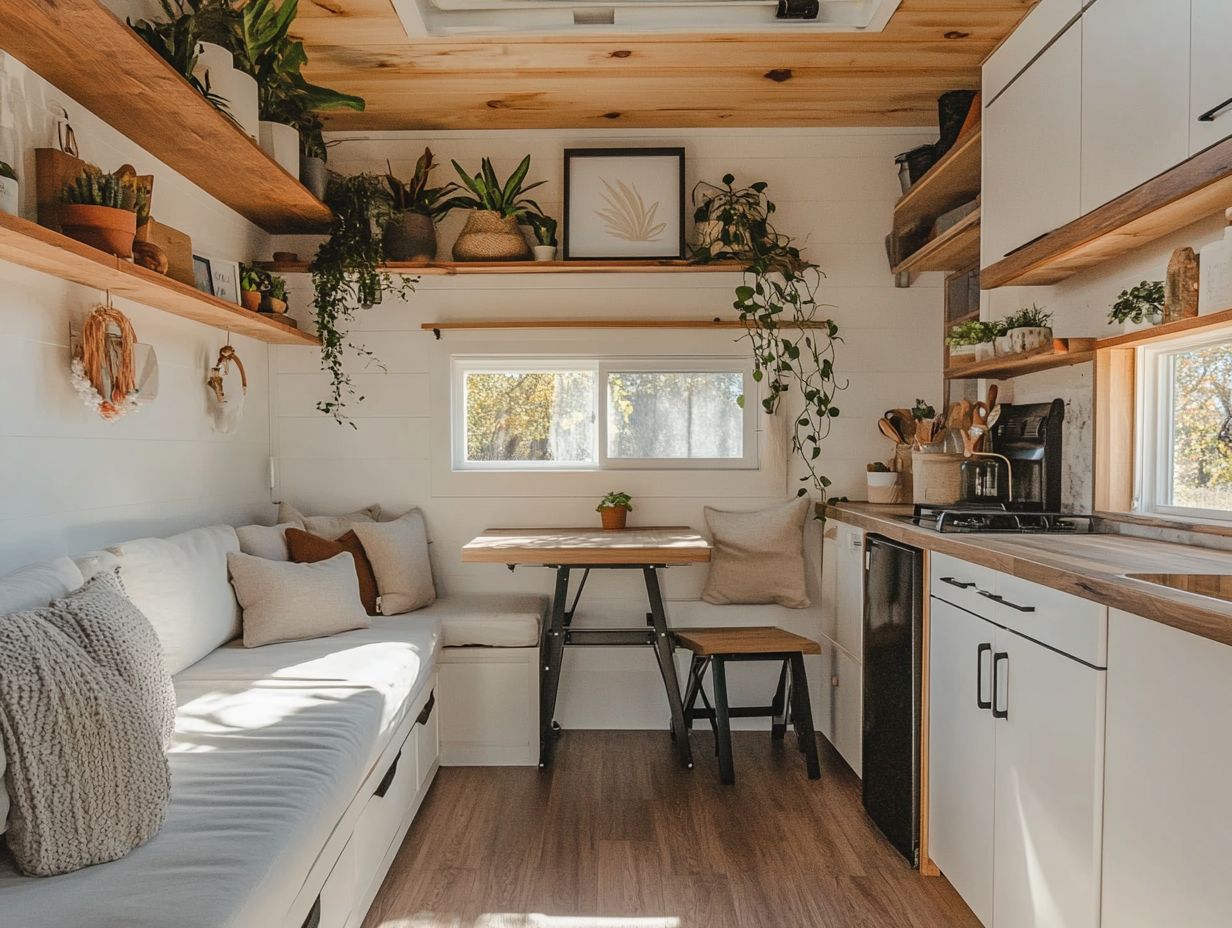
What are the best tips for decorating a tiny home?
1. Keep It Minimal: Less is more in a small space. Stick to essentials and avoid clutter to make your home feel more spacious.
2. Use Vertical Space: Take advantage of wall space by installing shelves or hanging plants. This adds extra storage and decor.
3. Choose Multipurpose Furniture: Look for furniture that serves multiple functions, like a storage ottoman or a sofa bed.
4. Incorporate Mirrors: Mirrors create the illusion of a larger space and reflect light, making your tiny home feel brighter and more open.
5. Select a Cohesive Color Scheme: A consistent color palette creates harmony, making your home feel more put-together.
How can I make my tiny home feel cozy?
1. Layer Textiles: Add throw pillows, blankets, and rugs for warmth and texture.
2. Incorporate Natural Elements: Bring the outdoors in with plants or natural decor to create a calming atmosphere.
3. Use Soft Lighting: Soft, warm lighting creates a cozy ambiance. Avoid harsh lighting, which can feel stark and uninviting.
4. Personalize with Meaningful Items: Adding personal touches, like photos or artwork, makes your tiny home feel more like your own.
5. Play with Textures: Mixing textures, like knits, wood, and metal, adds visual interest and enhances coziness.
How do I maximize storage in a tiny home?
1. Use Hidden Storage: Look for furniture with hidden compartments or use under-bed storage containers to save space.
2. Opt for Vertical Storage Options: Install shelves or vertical organizers to make use of unused wall space.
3. Invest in Multi-Functional Furniture: Choose pieces that can serve multiple purposes, like a desk that doubles as a dining table.
4. Declutter Regularly: Keep your tiny home organized by periodically purging items you no longer need.
5. Get Creative with Storage Solutions: Use tension rods, command hooks, and over-the-door organizers to maximize storage in small spaces.
What are some budget-friendly decorating options for a tiny home?
1. Upcycle and Repurpose: Instead of buying new items, give old ones a fresh look with paint or new fabric.
2. Shop Secondhand: Find unique decor pieces at thrift stores, flea markets, or online marketplaces.
3. Try DIY Projects: Get creative and make your own decor using inexpensive materials, like pallet wood or thrifted items.
4. Use Natural Elements: Incorporate decor like branches, seashells, or rocks to add a touch of nature without spending money.
5. Keep It Simple: Embrace simplicity! Stick to a few well-chosen, budget-friendly pieces instead of cluttering your space.
What are some space-saving hacks for a tiny home?
Here are some additional ideas that align with the Tiny House Movement philosophy:
1. Use Wall-Mounted Items: Install shelves, hooks, and organizers on your walls to save space on surfaces and floors.
2. Choose Furniture with Built-In Storage: Look for options that serve multiple purposes and provide storage, like a bed with drawers underneath.
3. Think Outside the Box: Get creative with unconventional storage solutions, such as using a hanging shoe organizer for pantry items.
4. Make Use of Wasted Space: Identify empty nooks or corners that can be utilized for storage, like a corner shelf or hanging basket in the bathroom.
5. Fold and Stack When Possible: Opt for foldable furniture, like a dining table or chairs, to maximize space when not in use.

